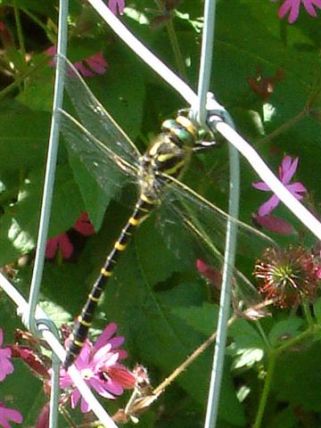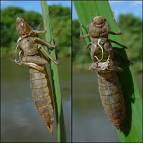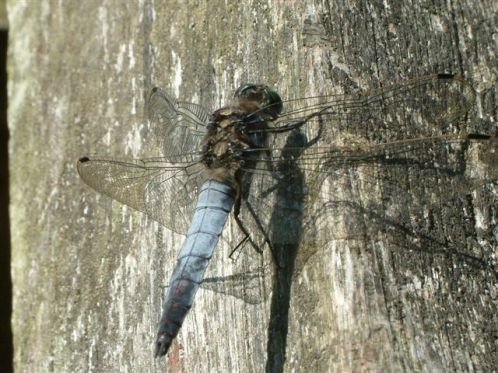On a warm sunny day, take a walk down to the Sissinghurst lakes and find a comfortable place at the edge to sit yourself down. It won’t be long before you’ll see creatures skimming and darting low over the water’s surface, hunting for food or perhaps searching for a mate. These flying insects might settle on a reed for a moment or two before taking to the air again in their continuing search. What you are witnessing, a brief insight into, is the daily struggle for survival and reproduction of some of our most wonderful insects: dragonflies and damselflies.
Dragonflies have been flying for more than 250 million years, long before dinosaurs roamed the land, and have changed little. These masters of flight can reach speeds of 30mph using their skills to take flight, catch prey and come to rest all within 1 to 1.5 seconds. By having the ability to move all wings independently, as well as being able to rotate their wings forward or backward on an axis, their manoeuvrability makes them excellent hunters, as well as being very adept at avoiding becoming prey themselves.
How can you be sure if you’re looking at a dragonfly or a damselfly though?
Damselflies tend to be smaller and more delicate looking than the robust dragonfly. The flight pattern of the dragonfly is powerful and persistent with frequent hovering, whilst damselflies tend to be weaker and all too brief. At rest, the damselfly will usually have its wings closed above its back, whereas the dragonfly will rest with the wings held out at 90 degrees to the body. Getting to know some of these subtle differences will aid you significantly when it comes to identification.
What you are watching on this sunny day, are formidable and complex creatures in the twilight of their lives; for they only live for up to three months on the wing. Go back further in their life cycle and they have a very different existence in an often unseen world. Soon after the female adult has laid her eggs, on or close to the surface of the water, the eggs will hatch and a nymph (or lava) will emerge.
The nymph will develop and grow for up to five years: in the case of the Golden-Ringed Dragonfly, and during that time will be one of the top predators on the pond floor. When time and conditions dictate, the nymph will emerge from the water, breaking through its larval skin to emerge as a young adult. Look closely at lake-side reeds in Spring, and you might spot the shell of the nymph left behind, known as the exuvia.
We are lucky here at Sissinghurst, insomuch as we have excellent habitats (though these do require looking after) that attract a wide range of dragonflies and damselflies.
All the photos you see here were taken at Sissinghurst, and are just some of the the twenty-three odonatas (the order covering dragonflies and damselflies) that can be seen on-site. So the next time you are here and if the sun is out and the weather warm; do head down to the lakes. Find that spot and sit yourself down, and with a bit of patience you can get a glimpse into the world of one our most fascinating insects… an insect that pre-dates the dinosaurs and out-lived them all.
Paul Freshwater: Ranger






Thank you for this really interesting post. Absolutely fascinating insects and the photos are great. I often forget that it’s not just the garden and the buildings to enjoy at Sissinghurst! Another visit is now necessary, come out sun!!
LikeLike
Thank you for your kind comments Alison, lets hope the sun continues to shine for these wonderful insects!
LikeLike
This is a wonderful and informative post, as are all the entries. I live in Edinburgh but love reading what happens at Sissinghurst. I congratulate all contributors to the blog and hope to visit (again) one day.
LikeLike
Thank you Kate and we hope you can return to Sissinghurst in the near future – Paul
LikeLike
The gentle dragons albeit brownish they are lovely xxx
Sent from my mini iPad
>
LikeLike
Hello Alison, I just love the variety of colours and shades they all come in, I’d just wish they’d stay still a bit longer for the photos! – Paul
LikeLike